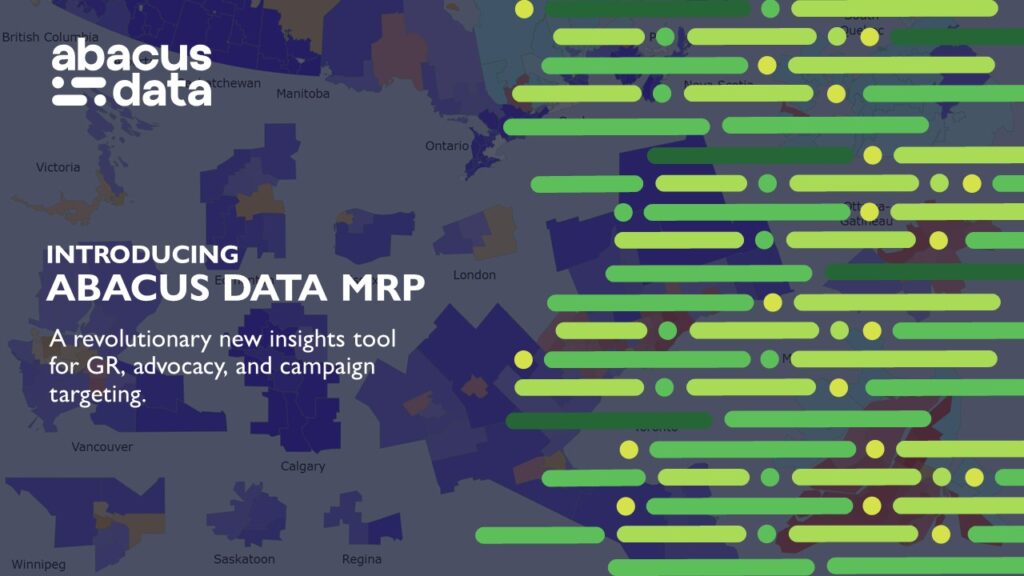Abacus Data Poll: NDP passes Liberals outside of Quebec; Conservatives lead by 22.
From September 19 to 25, 2024, Abacus Data conducted a national survey of 1,700 Canadian adults exploring several topics related to Canadian politics and current events as part of our regular national omnibus surveys.
In this edition, we ask about our usual trackers, along with gauging preference for the next federal election’s timing as well as updating our look at what Canadians think a Conservative government should and would do.
Vote Intention: Conservatives remain well ahead, lead by 22 over the Liberals
If an election were held today, 43% of committed voters would vote Conservative, while 21% would vote for the Liberals, 19% for the NDP, and 5% for the Greens. The BQ has 37% of the vote in Quebec. The Liberal vote share is down 1, the NDP is up 1, and the Conservatives are unchanged from earlier this month.


Regionally, the Conservatives continue to lead across all regions and provinces except for in Quebec. The Conservatives lead by 22 in BC, by 37 points in Alberta, 32 points in Saskatchewan and Manitoba, 24 points in Ontario, and by 15 points in Atlantic Canada. The BQ leads by 9 points in Quebec where the Liberals are slightly ahead of the Conservatives.


Outside of Quebec, the NDP has now surpassed the Liberals into second place. The Conservatives have 50% of the vote outside Quebec, followed by the NDP at 22% and the Liberals at 19%.


Demographically, the Conservatives continue to lead among all age groups and among both men and women.
The Conservative vote share is fairly consistent across all age groups – ranging from 42% to 47% while the Liberals have more support among those aged 60+ than those under 60.

For the last four waves of tracking, there is a slight gender gap in Conservative support. 49% of men would vote Conservative compared with 38% of women. Liberal support is consistent between men and women while NDP support is 4-points higher among women than among men.

The Conservative Party’s lead grows to 26-points if you look at the vote intention of only those certain to vote in the next election. The Conservatives would get 46% compared with 20% for the Liberals and NDP respectively.

Despite a widening lead for the Conservatives over the Liberals, we have seen a small improvement in the mood of the country. Today, 27% think the country is headed in the right direction. At the same time, 18% feel the world is headed in the right direction, up four points from last month.


The federal government’s approval rating has improved slightly.
Today, 25% of Canadians approve of the job performance of the federal government (up 1) while disapproval is down three points to 59%.

The government’s deteriorating approval numbers are also reflective in views of the Prime Minister which remain significantly more negative than positive.
Today, 22% (unchanged) have a positive view of the Prime Minister, while 60% (down 1) have a negative impression of the Prime Minister, for a net score of -38.

And we also find that NDP Leader Jagmeet Singh’s negatives also continue to trend upward reaching 39% – a high for Mr. Singh in our tracking. His positives are also up slightly (+2) to 31% for a net score of -8.

Impression of Conservative Leader Pierre Poilievre have also become slightly more negative. While his positives are steady at 39%, those with a negative view are up two to 37% giving him a net score of +2.

Which party do Canadians think will win the next election and so Canadians want an election now?
Almost half of Canadians (47%) continue to believe that the Conservative Party is likely to win the next federal election. This is unchanged from July. 17% think the Liberals are going to win (down 2) while 11% think the NDP is going to win (up 2). 1 in 4 Canadians remain unsure about the outcome of the next election.

In this survey, we asked Canadians when they would like the next election to happen.
32% want a federal election to happen as soon as possible while 30% don’t want an election to happen until it’s schedule date in October 2025. 16% prefer an election to happen sooner than October 2025 but not before the end of the year. The remaining 22% say they don’t care.
Not surprisingly, Conservative supporters are most likely to want an election as soon as possible while Liberal supporters are most likely to want an election in October 2025. NDP supporters are split – 37% want an early election while 39% want to wait until October 2025. BQ supporters split in a similar fashion.
There is also a strong relationship between one’s desire for change and preferred timing of an election. 66% of those who want a change of government and think there’s a good alternative (54% of Canadians) would prefer an earlier election whereas those who believe Justin Trudeau and the Liberals deserve to be re-elected (15% of Canadians) would prefer an election in October 2025.


What do Canadians think a Conservative government would do if elected?
Twice previously we asked Canadians whether a Conservative Party will or won’t do several things to gauge perceptions about what a Conservative government means.
In the most recent wave we seen perceptions have shifted in some ways.
A majority of Canadians continue to believe that a Conservative government definitely or probably would eliminate the national carbon tax. Today 60% believe it will, up 2 points from December. This remains the most recognized policy change that a Conservative government would bring.
The survey also finds a big shift in perceptions about what a Conservative government would do about the national dentalcare program. Today, 49% believe a Conservative government will likely eliminate the program, up 14-points from December 2023.
Another half (48%) believe the Conservatives would cut all public funding to the English-language CBC – and this up 8 points since December.
There is also more Canadians who think the Conservatives would end the national childcare program (+5 to 45%), make it harder for women to have an abortion (+5 to 44%), and cut personal income taxes (+4 to 35%). More also think it will balance the budget (+4 to 35%).
Only a third of Canadians (34%) think the Conservatives will take dealing with climate change seriously (unchanged from December) while 20% think they will welcome as many immigrants to Canada as the Liberals (down 2 to 20%).

But when we turn to what a Conservative government should do, views are pretty stable.
Almost all Canadians believe the Conservatives should make housing more affordable (91%, unchanged) and balance the federal budget within 4 years (82%, up 3). Noteworthy, 79% want a Conservative government to take climate change seriously (79%, down 3).
A majority also want a Conservative government to cut personal income taxes (70%, down 1) and eliminate the carbon tax (61%, down 2).
Things few want the Conservatives to do remain ending the national childcare program (31%, up 5), welcome as many immigrants as the Liberals (30%, down 10 since December, and down 23 since May 2023), end the national dentalcare program (28%, up 3), and make it harder for women to have an abortion (24%, unchanged).
This confirms that national childcare and dentalcare as well as abortion and climate change remain vulnerable issues for the Conservatives. The gap between what people want and what people think the Conservatives might do highlight the risk for the party on these issues.

Digging a bit deeper, when we look at those who today say they would vote Conservative but didn’t vote for the party in 2021 (the new Conservative voters), perceptions of this group are instructive.
71% think a Conservative government will eliminate the carbon tax and 82% want them to.
65% think a Conservative government will make housing more affordable and 93% want them to.
73% wants a Conservative government to cut income taxes, but 53% think they will.
These three issues are ones where more wabt a future government to do something than think they will. These are their sword issues.
In contrast, 32% of new Conservative supporters think a Conservative government will make it harder for women to get an abortion and only 35% think they should.
Similarly,59% think a Conservative government shouldn’t end the national dental care plan, but 36% think they will.
Half think the party will take dealing with climate change seriously but 77% think they should.
These are areas where Conservative opponents can try and wedge these new Conservative supporters away from the party if perceptions about what it might do shift into something they don’t want it to do.
Overall, these questions show that the Conservatives and Mr. Poilievre have been very effective in focusing the public on its plan to eliminate the carbon tax, balance the budget, and make housing more affordable. But it also shows where the party remains vulnerable.
The Upshot
According to Abacus Data CEO David Coletto: “If an election was held today, the Conservatives would likely win a large majority government. This marks a continuation of a trend that has seen the Conservatives dominate across most regions of the country, with only Quebec being a place where their appeal has found fewer converts. Outside of Quebec, the NDP has overtaken the Liberals for second place, highlighting the continuing deterioration of the Trudeau Liberal Party’s prospects.
Despite slight improvements in the mood of the country, with 27% of Canadians feeling the country is headed in the right direction, and the federal government’s approval ticking up by a point to 25%, the Prime Minister’s personal approval remains stuck in negative territory at -38. Similarly, Conservative leader Pierre Poilievre’s favorability has held steady with a modest +2 net score, while NDP leader Jagmeet Singh has seen a rise in his negatives to a record-high of 39%.
Almost a majority of Canadians (47%) believe that the Conservatives are most likely to win the next federal election, a view unchanged since July. The desire for an election, however, remains divided: while 32% want one as soon as possible, 30% would prefer it happen as scheduled in October 2025. This split is driven largely by a desire for change among Conservative voters and those dissatisfied with the current government.
The survey also delves again into public expectations of a potential Conservative government, revealing that Canadians believe the party would eliminate the carbon tax, cut personal income taxes, and balance the federal budget. However, there is also growing belief that a Conservative government might roll back social programs like national dental and childcare plans, which remain popular among a significant portion of the electorate. These issues represent a vulnerability for the Conservatives, as the gap between what Canadians want and what they believe the party will do could provide an opening for their opponents to draw support away from them.
This survey underscores the Conservative Party’s strong positioning as the clear front-runner in Canadian politics but highlights areas of risk where public perception could shift, particularly on social issues like healthcare, climate change, and abortion.”
Methodology
The survey was conducted with 1,700 Canadian adults from September 19 to 25, 2024. A random sample of panelists were invited to complete the survey from a set of partner panels based on the Lucid exchange platform. These partners are typically double opt-in survey panels, blended to manage out potential skews in the data from a single source.
The margin of error for a comparable probability-based random sample of the same size is +/- 2.4%, 19 times out of 20.
The data were weighted according to census data to ensure that the sample matched Canada’s population according to age, gender, educational attainment, and region. Totals may not add up to 100 due to rounding.
This survey was paid for by Abacus Data Inc.
Abacus Data follows the CRIC Public Opinion Research Standards and Disclosure Requirements that can be found here: https://canadianresearchinsightscouncil.ca/standards/

ABOUT ABACUS DATA
We are Canada’s most sought-after, influential, and impactful polling and market research firm. We are hired by many of North America’s most respected and influential brands and organizations.
We use the latest technology, sound science, and deep experience to generate top-flight research-based advice to our clients. We offer global research capacity with a strong focus on customer service, attention to detail, and exceptional value.
And we are growing throughout all parts of Canada and the United States and have capacity for new clients who want high quality research insights with enlightened hospitality.
Our record speaks for itself: we were one of the most accurate pollsters conducting research during the 2021 Canadian election following up on our outstanding record in the 2019, 2015, and 2011 federal elections.
Contact us with any questions.
Find out more about how we can help your organization by downloading our corporate profile and service offering.















































